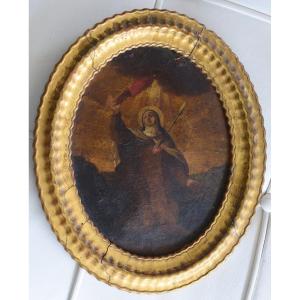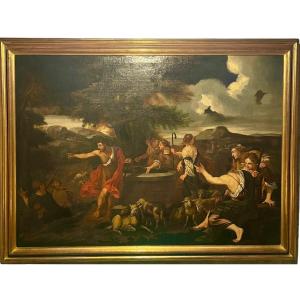The Virgin, leaning tenderly towards the Child, wears a deep carmine red cloak lined with black, with meticulously chiseled folds. Beneath this cloak, a white tunic with stylized ornaments is revealed. The Infant Jesus is dressed in a sumptuous orange garment with golden highlights, vibrant with light and symbolism, emphasizing both his human and divine dimensions. Both figures are surrounded by finely decorated golden halos, a legacy of the still-present Byzantine influence, but the faces and postures are beginning to reflect a gentleness and humanity characteristic of the Quattrocento. The gilded background, marked by time, retains traces of subtle decorative motifs, typical of works in the transition between the Medieval and Renaissance styles.
The halos, finely gilded, are richly decorated with filigree motifs, confirming the still-present Byzantine influence. The gilded background, typical of icons from the Trecento and Quattrocento periods, retains faded geometric motifs that accentuate the solemnity of the scene.
This icon bears witness to the transition between medieval aesthetics and Renaissance innovations, with a more nuanced color palette and balanced composition. This piece will appeal to collectors of sacred art, lovers of the Early Renaissance, or those seeking an object of historical and spiritual significance.
The theme of the Virgin and Child is one of the most iconic in the Christian tradition. Here, it is approached with a new emotional sincerity, reflecting the humanist ideals of the Quattrocento. Stylistically, the work is in the vein of the Venetian School, with visible affinities with the works of Gentile da Fabriano, or even the early followers of Fra Angelico.
This icon is from the Quattrocento; certain stylistic elements correspond to this period and support this dating:
- The folds of the clothing, although still stylized, show an attempt at realism, typical of the Early Renaissance.
- The treatment of the faces, with soft, melancholic, and human features, marks a break with the Byzantine hieratic frontality, towards a more psychological and embodied approach.
- The use of a golden background and halos remained common in the early Quattrocento. However, this icon still seems very much anchored in the Byzantine tradition, which could indicate a transitional work, typical of the early 15th century or a region less advanced in Renaissance innovations.
Method: Tempera and gilding on wood panel. Dimensions: 28 cm x 24 cm
Condition: Good overall condition considering its age – natural wear, some surface flaking and cracking, with no major alteration to legibility or pictorial structure. The colors retain exceptional luminosity, particularly the deep reds and finely patinated golds.
This painting is a valuable example of the evolution of Christian iconographic language in Italy at the dawn of the Renaissance. It testifies to the fundamental transition from medieval hieratic sacrality to a more empathetic and realistic approach to holy figures, making it a key historical and artistic testimony.
Ideal for collectors of sacred art, lovers of the Early Italian Renaissance, or those passionate about spirituality and Christian iconography.
Very careful shipping
#Icon #SacredArt #VirginandChild #Quattrocento #ItalianRenaissance #ReligiousIcon #ChristianArt #WoodPainting #ItalianSchool #15thCenturyArt #Iconography #GentileDaFabriano #FraAngelico #ByzantineInfluence #Antiques #Proantic








































 Le Magazine de PROANTIC
Le Magazine de PROANTIC TRÉSORS Magazine
TRÉSORS Magazine Rivista Artiquariato
Rivista Artiquariato